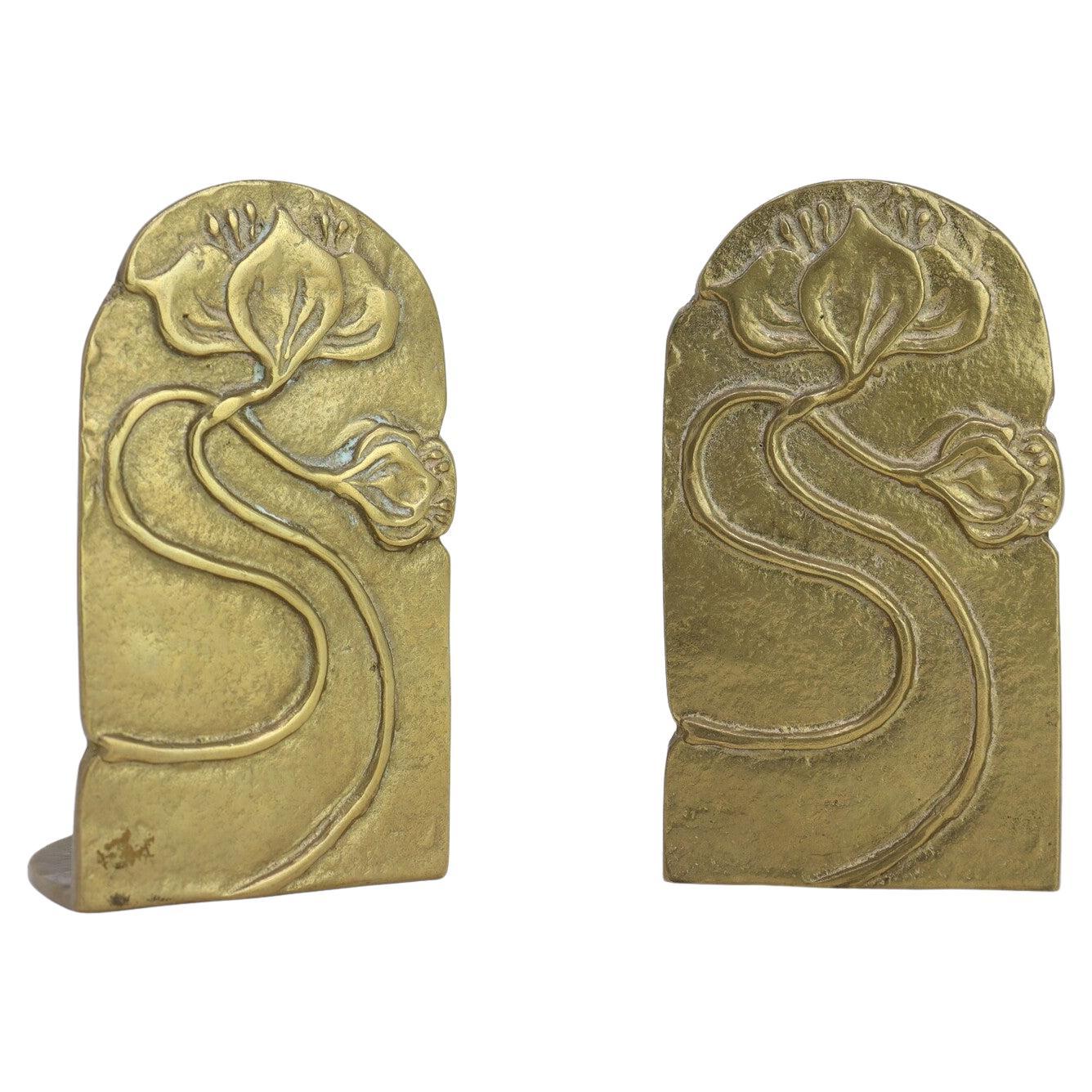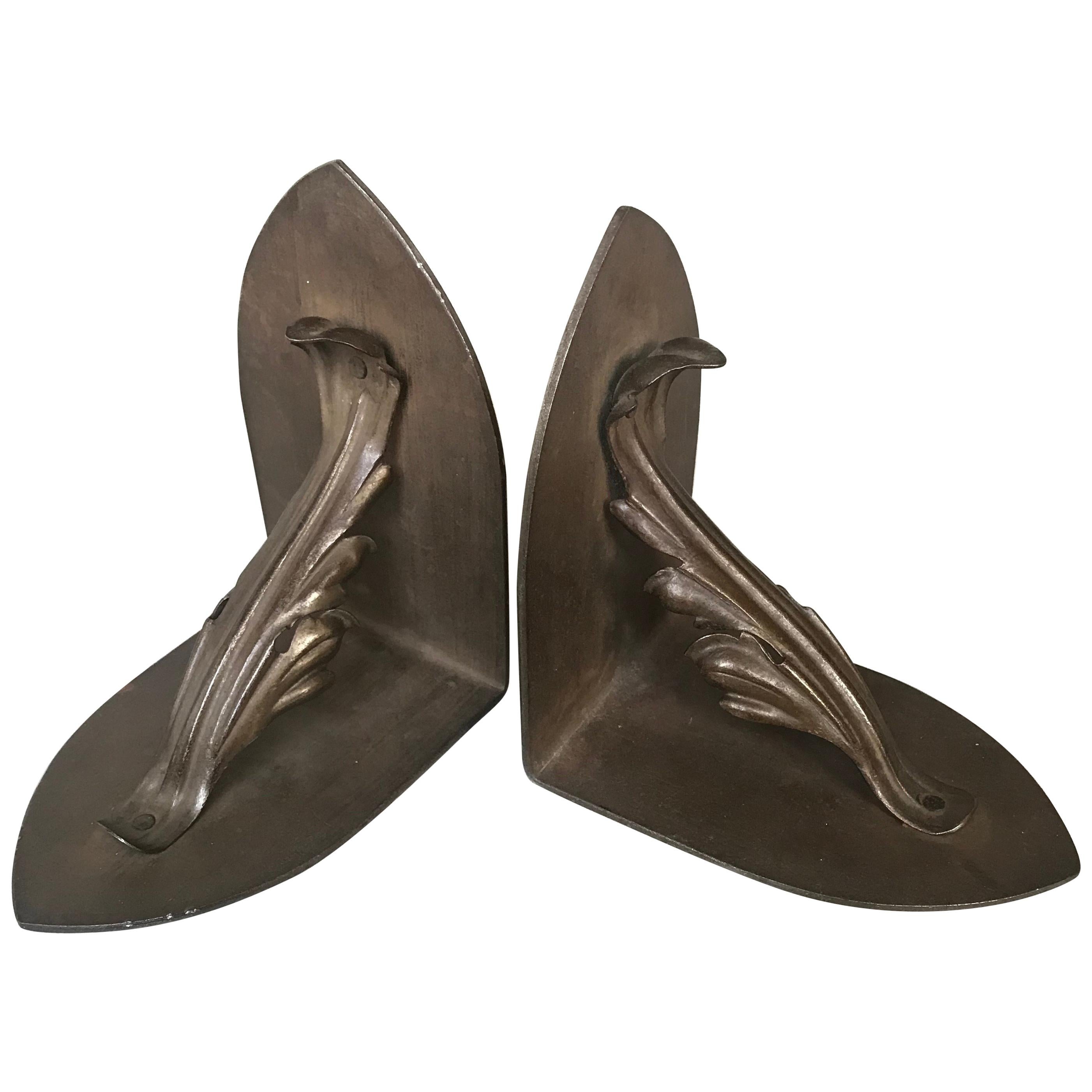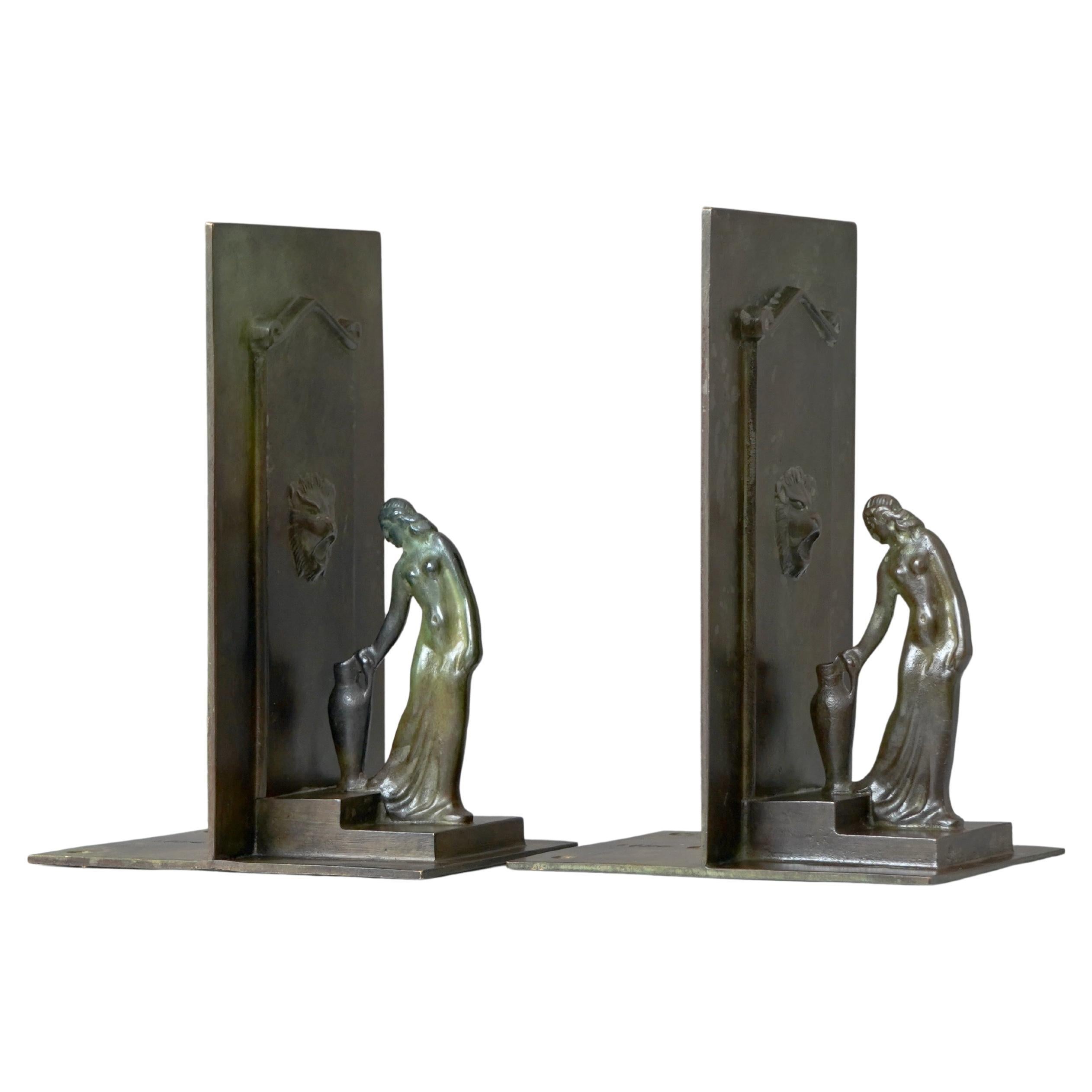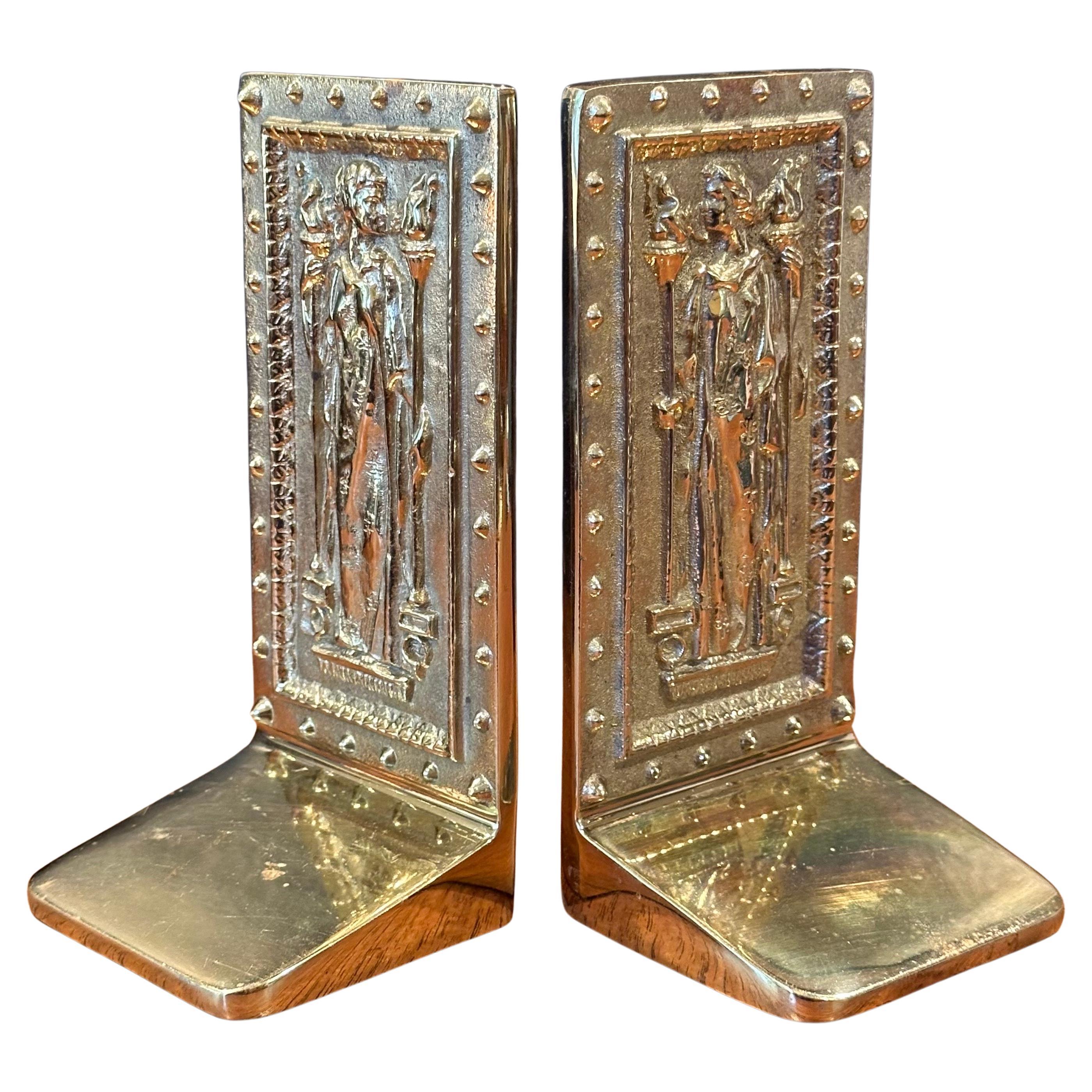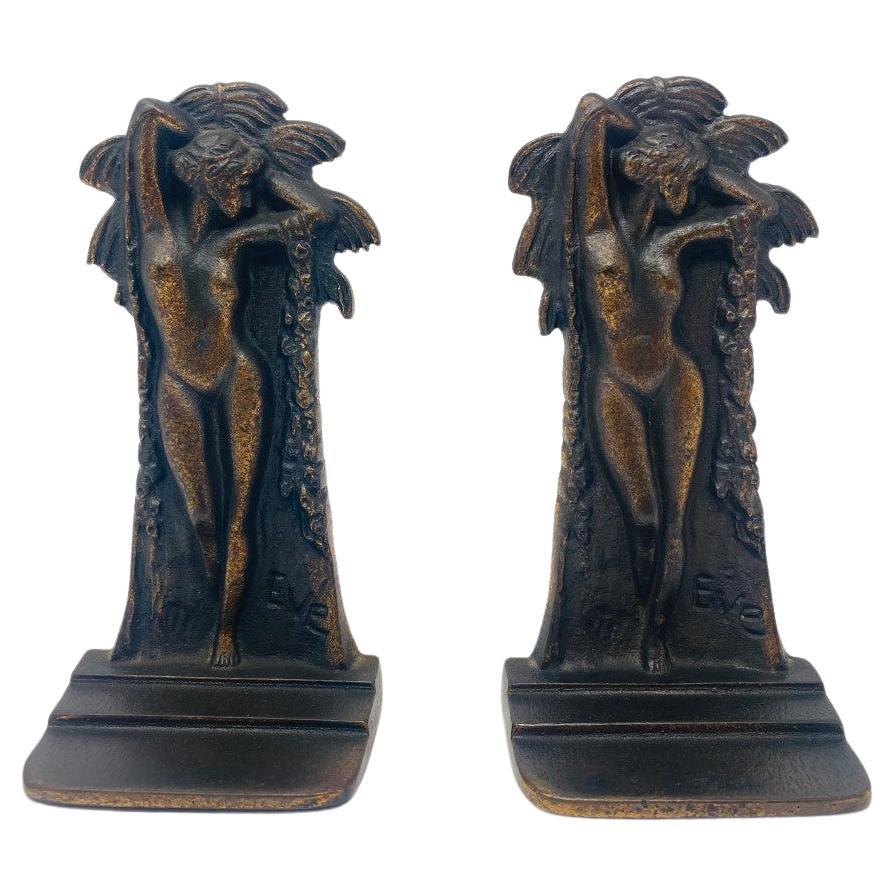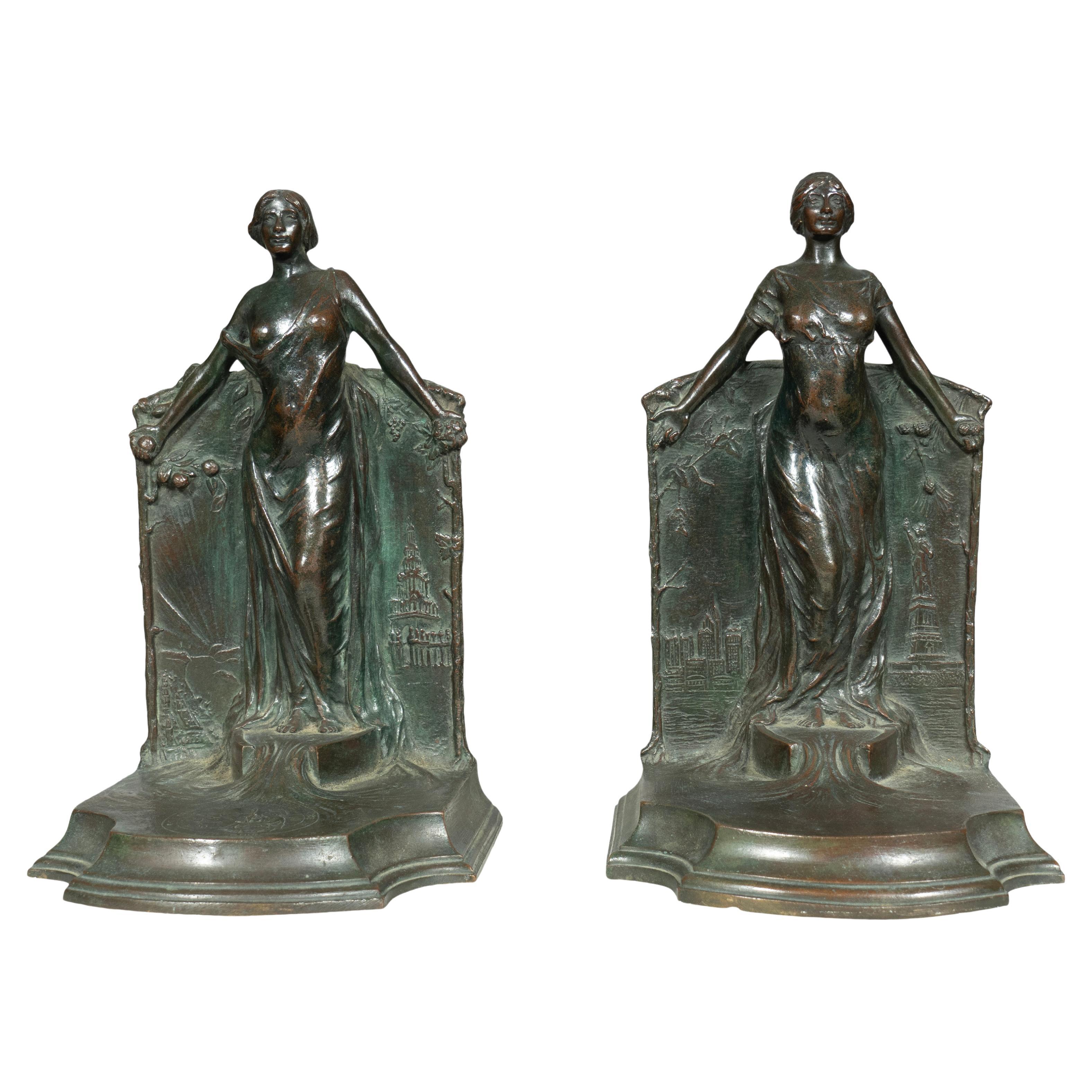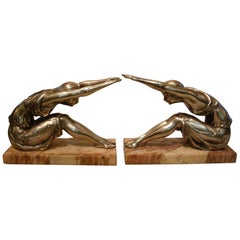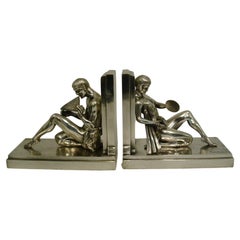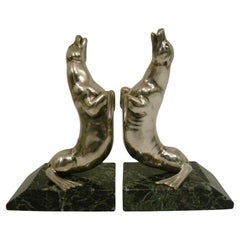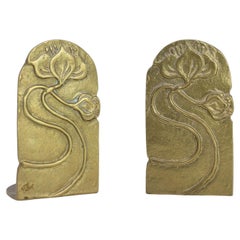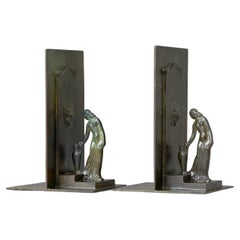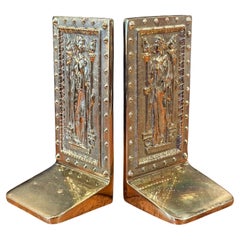Items Similar to Art Nouveau Newcomb College Pierced Brass Bookends
Want more images or videos?
Request additional images or videos from the seller
1 of 7
Art Nouveau Newcomb College Pierced Brass Bookends
$1,599per set
$3,500per set54% Off
£1,214.16per set
£2,657.63per set54% Off
€1,388.48per set
€3,039.20per set54% Off
CA$2,234.03per set
CA$4,890.01per set54% Off
A$2,484.73per set
A$5,438.76per set54% Off
CHF 1,297.45per set
CHF 2,839.95per set54% Off
MX$30,236.58per set
MX$66,183.87per set54% Off
NOK 16,570.43per set
NOK 36,270.49per set54% Off
SEK 15,540.14per set
SEK 34,015.32per set54% Off
DKK 10,362.77per set
DKK 22,682.73per set54% Off
Shipping
Retrieving quote...The 1stDibs Promise:
Authenticity Guarantee,
Money-Back Guarantee,
24-Hour Cancellation
About the Item
Art Nouveau pair of Newcomb College Pierced Brass Bookends
A pair of Newcomb College Pierced Brass Bookends, circa 1930, by Rosalie Roos Wiener, decorated with oxeye daisies, silvered patina, unmarked. A nearly identical pair of bookends is illustrated on p. 154 of The Newcomb Style by Jean Bragg and Susan Saward (2002).
We have specialized in the sale of Art Deco and Art Nouveau and Vintage styles since 1995. If you have any questions we are at your disposal. Pushing the button that reads 'View All From Seller'. And you can see more objects to the style for sale. Why are there so many antiques in Argentina?
In the 1880 – 1940 there was a grate wave of immigration encouraged by the periods of war that were taking place. 1st World War took place between 1914 and 1918 2nd World War took place between 1939 and 1945 The immigrants options were New York or Buenos Aires. Tickets were cheap and in Buenos Aires they were welcomed with open arms, as it was a country where everything was still to be done. Argentina was the country of new opportunities, labour was needed and religious freedom was assured, in many cases the of the family travel first until they were settled and then the rest of the family members join them. In the immigrant museum “Ellis Island Immigrant Building” in New York you can se the promotional posters of the boats that would take them to a new life. Between the years 1895 and 1896, Argentina had the highest DGP (gross domestic product) per capita in the world according to the Maddison Historical Statistics index, this situation arose due to the large amount of food being exported to European countries, which were at war. The Argentinean ships left the port of Buenos Aires with food, but they returned with furniture, clothes and construction elements, (it´s common to see this the old buildings of the historic neighbourhood of San Telmo, the beams with the inscription “Made in England)”, as well as many markets that were built in Buenos Aires, such us the San Telmo Market, whose structure was brought by ship and afterwards assembled in 900 Defensa Street. With the great influence of European immigrants living in the country, the children of the upper classes travelled to study in France, resulting in the inauguration of “La Maison Argentinienne”, on 27th of June 1928, in the international city of Paris, which hosted many Argentinians that were studying in Frace. It´s the fourth house to be built after France, Canada and Belgium, being the first Spanish-speaking one. Still in place today (17 Bd Jourdan, 75014, Paris, France). Many of the children of these wealthy families who attended international art exhibitions, museums and art courses abroad, took a keen interest in the European style. This is why Buenos Aires was at the time referred as “The Paris of South America”. Between the years 1890 and 1920 more than a hundred Palaces were built on Alvear Avenue the most exclusive avenue in Buenos Aires. Today some of these palaces have been transformed into museums, hotels and embassies. In the year 1936, the Kavanagh building was inaugurated, it was the tallest reinforced concrete building in South America. During 1994 the American Society of Civil Engineers distinguished it as an “international engineering milestone”, and it´s now considered a World Heritage of Modern Architecture. At the time was common to hire foreign architects such as Le Corbusier, who visited Buenos Aires/Argentina in 1929 and in 1948 he drew up the blueprints for a house built in La Plata City (which was declared a World Heritage Site). In 1947, the Hungarian architect Marcelo Breuer designed “Parador Ariston” in the seaside city of Mar del Plata. After an Argentinean student at Harvard University convinced him to come to Argentina. He worked on an urban development project in the Casa Amarilla, area of La Boca. The Ukrainian architect, Vladimiro Acosta, arrives in Argentina in 1928 and worked as an architect until que moved to Brazil. Antonio Bonet, a Spanish architect who worked with Le Corbusier in Paris, arrives in Argentina in 1937, where he carried out several architectural works and in 1938 designs the well-known BFK chair. Andres Kálnay, of Hungarian origin, made around 120 architectural masterpieces, among which the former Munich brewery stands out, he even made the furniture’s design. The German architect, Walter Gropius, director of the Bauhaus, lived in Argentina, where he wrote articles for “Sur” magazine and founded in Buenos Aires, an architectural firm with Franz Möller, who was also an architect, where he built two houses. At the same time several famous designers decided to immigrate to Argentina, among them we can find the well-known French designer, Jean-Michel Frank, who arrived in the country in 1940 and also worked for the Rockefeller family. Special pieces were made, which were sold exclusively in the country, such as the well-known German company “WMF”, who sold their products by catalogue, which were chosen by the ladies of high society in the list of wedding gifts, as well as the pieces designed by Christofle. The Swiss sculptor Alberto Giacometti, made special pieces for Argentinean mansions. In 1904 the first Jansen branch outside Paris was established in Buenos Aires, as the Argentinean clientele demanded a large amount of furniture, from the end of the 19th century to the mid-20th century. In 1970, the brand Rigolleau Argentina made pieces authorised by Lalique. The brands Maple and Thompson also set up shop in the country. The French plastic artist, Marcel Duchamp moved to Argentina in 1918-1919. Glass signed Gallé, Charder, Leverre, Schneider, Muller and other French firms. They were bought in flower shops and were given to ladies with beautiful floral arrangements. Some furniture manufacturers travelled to international fairs and bough the patterns to produce the furniture in Argentina, such as the furniture firm Englander and Bonta, who bought the patterns in Italy. It is worth mentioning that in Argentina we have the largest community of Italians outside of Italy, as it is estimated that 70 percent of the inhabitants have at least one Italian descendant, followed by Spanish immigrants. The most Important furniture stores in Argentina: Comte is founded in 1934 (under the direct management of Jean Michel Frank in 1940). Nordiska (Swedish company established in 1934). Churba in 1960, a company that brought foreign designers to present their furniture in the country: Denmark: (Arne Jacobsen, Finn Juhl, Bender Madsen, Ejner Larsen, Poul Kjaerholm, Hans Wegner) Sweden: (Hans Agne Jakobsson, Gustavsberg) United States: (Herman Miller) Finland: (Lisa Johansson, Folke Arstrom, Tapio Wirkkala, Alvar Aalto, Timo Sarpaneva) Swedish Factory: (Orrefors) Italy: (Littala, Vico Magistretti, Emma Gismondi, Gae Aulenti, Angelo Mangiarotti, Elio Martinelli, Gianna Celada, Angelo Mangiarotti, Mario Bellini, Carlo Scarpa) Finland: (Olivia Toikka) Plata Lappas (Lappas Silver): a goldsmith shop founded in 1887 in Argentina by Alcibiades Lappas of Greek origin. In 2019, in Argentina took place “the Art Deco world congress” . Argentina currently has more than 100 Art Deco buildings and another 90 Art Nouveau buildings throughout the city of Buenos Aires. Argentina is a country that has not been involved in many wars, which is why it has been a refuge for works of art and antiques from different periods of time, unlike European countries. That is way many collectors, museums and antique dealers from all over the world visit it, you should not miss the opportunity to visit this great country.
- Similar to:Rosalie Roos Wiener (Artist)
- Dimensions:Height: 7.37 in (18.7 cm)Width: 3.15 in (8 cm)Depth: 4.53 in (11.5 cm)
- Sold As:Set of 2
- Style:Art Nouveau (In the Style Of)
- Materials and Techniques:Brass,Silvered
- Place of Origin:
- Period:
- Date of Manufacture:1910´s
- Condition:Wear consistent with age and use.
- Seller Location:Buenos Aires, AR
- Reference Number:1stDibs: LU202739557723
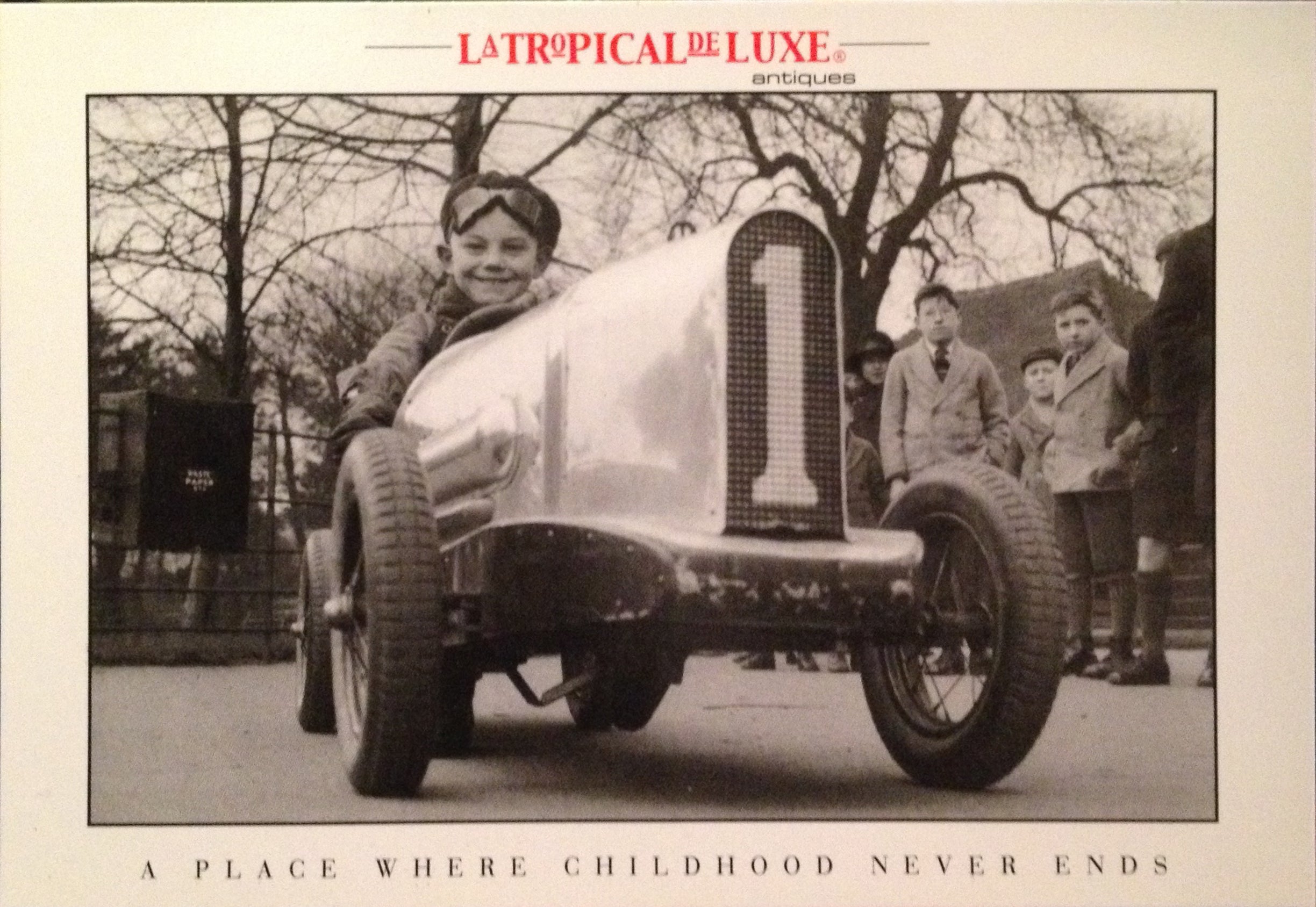
About the Seller
4.9
Vetted Professional Seller
Every seller passes strict standards for authenticity and reliability
Established in 2002
1stDibs seller since 2016
320 sales on 1stDibs
Typical response time: 1 hour
- ShippingRetrieving quote...Shipping from: Buenos Aires, Argentina
- Return Policy
Authenticity Guarantee
In the unlikely event there’s an issue with an item’s authenticity, contact us within 1 year for a full refund. DetailsMoney-Back Guarantee
If your item is not as described, is damaged in transit, or does not arrive, contact us within 7 days for a full refund. Details24-Hour Cancellation
You have a 24-hour grace period in which to reconsider your purchase, with no questions asked.Vetted Professional Sellers
Our world-class sellers must adhere to strict standards for service and quality, maintaining the integrity of our listings.Price-Match Guarantee
If you find that a seller listed the same item for a lower price elsewhere, we’ll match it.Trusted Global Delivery
Our best-in-class carrier network provides specialized shipping options worldwide, including custom delivery.More From This Seller
View AllArt Deco Turkey Bronze Bookends Signed Irenee Rochard
By Irénée Rochard
Located in Buenos Aires, Olivos
Art Deco Turkey bronze bookends signed Irenee Rochard. Very nice with original patina, mounted over marble bases.
Irénée René Rochard (French, 1906 ~ 19...
Category
Vintage 1920s French Art Deco Animal Sculptures
Materials
Bronze
Art Deco Woman Sculpture Bookends, France, 1920s
Located in Buenos Aires, Olivos
Art Deco female figure - Sculpture bookends, France, 1920s.
Pair of female bookends in silver plated finish, great pose in the Art Deco style, made in France.
We have specialized in...
Category
Early 20th Century French Art Deco Figurative Sculptures
Materials
Metal
Art Deco Musical Figural Bookends by Emile Carlier, France 1925
By Émile Nestor Joseph Carlier 1
Located in Buenos Aires, Olivos
Art Deco Bookends by Emile Joseph Nestor Carlier, French, c 1925, cast in silvered metal as a man clad in a loin cloth playing the pans flute and a similarly clad woman playing the cymbals, covered in a silver plating signed "Carlier" on the base, "Fabrication Francaise...
Category
Early 20th Century French Art Deco Bookends
Materials
Metal
$1,440 Sale Price
20% Off
Free Shipping
Art Deco Seal Bookends Louis Albert Carvin France 1930
By Louis-Albert Carvin
Located in Buenos Aires, Olivos
Nice pair of Art Deco seal bookends designed by the French artist Louis Albert Carvin, silvered white metal on a green marble base, France, 1930.
“Anima...
Category
Early 20th Century French Art Deco Animal Sculptures
Materials
Marble, Metal
Silvered Bronze Bookends Sculptures of a Mermaid and Merman, France, 1900
By Jean Garnier
Located in Buenos Aires, Olivos
Silvered bronze bookends sculptures of a Mermaid and Merman, France, 1900.
This enchanting bronze sculpture is the object of many sailors dreams. Silvered bronze sculptures of a merm...
Category
Early 20th Century French Art Nouveau Figurative Sculptures
Materials
Bronze
Art Deco Bronze Bookends Deer Sculpture with Wooden Base, circa 1920s
Located in Buenos Aires, Olivos
Art Deco bookends slim deer sculpture with wooden base.
They have the Hagenauer style.
Art Deco dark green patinated bronze leaping deer bookends
Unsigned.
We have specialized in th...
Category
20th Century French Art Deco Animal Sculptures
Materials
Bronze
$1,120 Sale Price
20% Off
Free Shipping
You May Also Like
Pair Of Art Nouveau Bookends
Located in Brussels, BE
Pair Of Art Nouveau Bookends
Category
Antique Late 19th Century European Art Nouveau Bookends
Materials
Metal
$539 / set
Arts & Crafts Pair of Handcrafted Metal Bookends with Meaningful Symbolic Leaves
Located in Lisse, NL
Wonderful pair of hand-crafted, early 20th century bookends.
With the symbolic meaning of leafs ranging from hope, renewal, revival, fertility and growth to decay, sadness and even ...
Category
Early 20th Century German Art Deco Bookends
Materials
Metal
$467 / set
Free Shipping
Bronze Art Deco Bookends by GAB Guldsmedsaktiebolaget, Sweden, 1930s
By Sune Bäckström, GAB Guldsmedsaktiebolaget, Just Andersen
Located in Malmö, SE
A pair of rare bronze Art Deco / Swedish Grace bookends with amazing patina.
Made by GAB Guldsmedsaktiebolaget, Sweden, 1930s.
Great condition, only a few light scratches.
Stampe...
Category
Vintage 1930s Swedish Art Deco Bookends
Materials
Bronze
Pair of Brass "Doors to Library of Congress" Bookends by Virginia Metalcrafters
Located in San Diego, CA
Beautiful pair of rare solid brass "Humanitas & Intellectus" collectible bookends with "The Doors to the Library of Congress" on the frontside manufactured by Virginia Metalcrafters,...
Category
Late 20th Century American Hollywood Regency Bookends
Materials
Brass
Vintage Art Nouveau “Eve” Bookends 1930s by Verona
Located in San Diego, CA
Beautiful pair of vintage Art Noeveau bookends by Verona. This set in beautifully aged cast iron reminiscence of the art noeveau era with its use of arches and curved forms. In this ...
Category
Vintage 1930s American Art Nouveau Bookends
Materials
Iron
$300 Sale Price / set
20% Off
Pair Of Bronze Bookends By Rudolf Schwarz and Cast By Gorham Foundry
Located in Essex, MA
Featuring monuments to the states of New York and California. Rudolf Schwarz was an Austrian born American sculptor. Emigrated to Indianapolis in 1897 to help complete the Soldiers a...
Category
Early 20th Century American Art Nouveau Bookends
Materials
Bronze
More Ways To Browse
S S Pierce
Pierced Brass
Art Nouveau Homes
Canada Antiques
Finnish Antiques
South Street Antiques
Brass Directors Chairs
Art Deco Accent Chairs
70s Brass Chairs
Spanish Accent Chair
Lalique Bookends
Breuer Brass Chair
Marcel Breuer Brass Chairs
70s Accent Chair
Daisy Chair
Susan Silver Antiques
Lalique Daisy
Roycroft Copper Bookends
